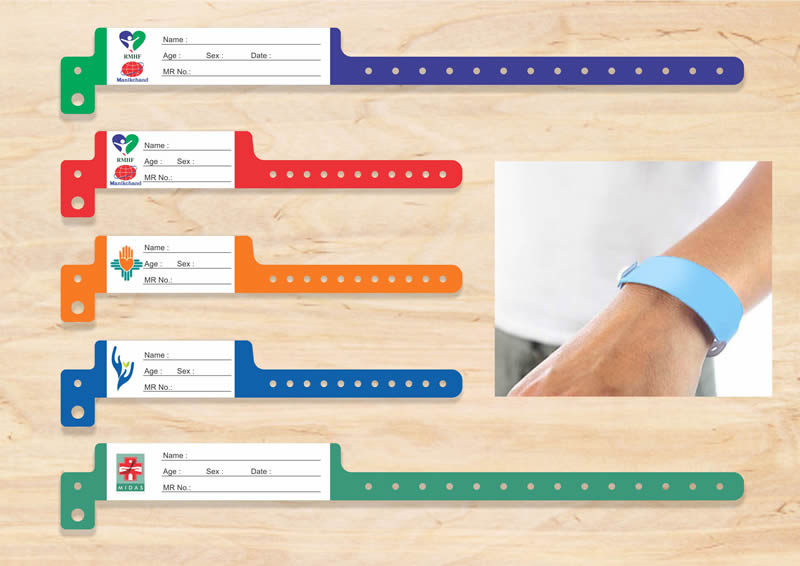Why a Patient Identification Band is Essential in Busy Environments like Emergency Rooms
Why a Patient Identification Band is Essential in Busy Environments like Emergency Rooms
Blog Article
Discovering the Numerous Sorts Of Patient Identification Band Utilized in Medical Facilities
In the intricate globe of health care, the crucial function of Patient Identification bands often goes unnoticed. These bands, differing from basic paper wristbands to sophisticated RFID bands, develop the backbone of Patient security protocols, making certain accuracy in Patient Identification. The vast variety of these bands, each with its distinct advantages and restrictions, is frequently forgotten. As we browse through this topic, one might get insight into the refined intricacies and important value of such bands in medical centers.
Understanding the Significance of Patient Identification Bands
While they might appear like plain accessories, Patient Identification bands play a crucial role in clinical centers. These bands function as an important device for validating Patient identity, preventing medical errors associated with misidentification. The bands typically display essential details such as the Patient's name, age, blood group, and any well-known allergies. They allow healthcare professionals to quickly access this important information, thus helping with prompt and precise medical treatment. Patient Identification bands additionally aid in enhancing management jobs, ensuring accurate record-keeping and billing. Despite their simplicity, these bands embody the principle of Patient safety and security, a cornerstone of quality healthcare. Without them, the risk of medical errors, and consequently, Patient injury, could significantly increase.
Conventional Paper Wristbands: Their Usage and Limitations
Traditional paper wristbands have been a staple in Patient Identification across numerous clinical centers. While their usage is widespread, they nurture particular limitations that might influence their performance in Patient monitoring. This area will focus on the scope of their application and the fundamental drawbacks connected with their usage.
Paper Wristbands: Use Scope
In the realm of Patient Identification, paper wristbands have long held a critical role. These bands are commonly utilized in outpatient settings, where the Patient's stay is momentary. The wristbands include essential details such as the Patient's name, day of birth, and a special Identification number. This straightforward, yet efficient system, allows clinical specialists to swiftly and accurately identify individuals, making sure the correct treatment is provided. Paper wristbands are also utilized in emergency situation situations, where fast Identification is paramount. Their usage reaches events like blood contribution drives and mass inoculation programs, further highlighting their versatility. In spite of advancements in modern technology, the humble paper wristband stays a reliable and economical solution for Patient Identification in different medical care scenarios.
Limitations of Paper Wristbands
Despite their extensive usage, paper wristbands are not without their downsides. Their physical durability is among the considerable limitations. Direct exposure to water, sweat, or harsh handling can provide them unreadable or also cause them to degenerate. On top of that, paper wristbands typically lack the technological capabilities of even more modern-day options, such as barcoding or RFID chips, limiting their capability to merely presenting composed details. The lack of ability to update or customize the information on the wristband is another imperfection. Additionally, if the information is transcribed, legibility can be jeopardized, resulting in potential misidentification. Paper wristbands can trigger discomfort or skin irritability to some clients, especially when put on for prolonged durations.
Barcoded Wristbands: Developments in Patient Identification
While Patient Identification has long been an important aspect of health care, the advent of barcoded wristbands signifies a substantial leap onward. These bands utilize the simpleness of barcoding technology, enabling Patient info to be quickly checked and accessed. They improve the rate and accuracy of Patient Identification, decreasing the risk of clinical mistakes connected to misidentification. Barcoded wristbands are cost-efficient, simple to generate, and get rid of handwriting mistakes typical with hand-operated systems. They are not without restrictions. While they offer enhancements over typical bands, the barcode More about the author can become smudged or worn, providing it unreadable. Regardless of this, barcoded wristbands remain a vital tool in modern healthcare setups, symbolizing the crossway of modern technology and Patient care.
Superhigh Frequency Identification (RFID) Bands: a Step Towards Futuristic Healthcare
The advancement of Patient Identification bands has caused the appearance of Superhigh frequency Identification (RFID) Bands (patient identification band). These ingenious gadgets present key benefits for medical care centers, using a much more efficient and technologically advanced means of Patient Identification. The implementation of RFID in medical care is a substantial action towards a more advanced technique to Patient monitoring and safety
Understanding RFID Bands

RFID Bands: Secret Benefits
Welcoming a future where innovation and healthcare combine, radio regularity Identification bands use several key benefits. Mainly, these bands enhance Patient security by providing exact, instant Identification, thus reducing clinical errors. RFID bands can save a vast amount of Patient information, including case history and allergies, allowing personalized treatment. They additionally enhance administrative tasks, as the automated information access replaces hands-on processes, enhancing efficiency and reducing documents. RFID bands use real-time tracking of clients, important in high-risk settings such as surgical treatment or extensive care. These bands are long lasting and resistant to ecological elements, making certain consistent performance. Overall, RFID bands represent a substantial advancement in Patient Identification technology, benefiting both individuals and doctor.
Executing RFID in Medical Care
As we enter a technically advanced era, the implementation of RFID bands in medical care becomes progressively crucial. These bands supply a seamless way to track and determine clients, ensuring their safety and boosting efficiency in therapy procedures. RFID bands supply countless benefits over typical Identification techniques. They can keep a substantial quantity of information, consisting of the Patient's medical history and therapy plans, which can be quickly accessed by health care carriers. This information assists doctors make informed choices relating to the Patient's treatment plan. RFID bands reduce clinical errors by providing precise Patient Identification, which is crucial in protecting against misdiagnosis or incorrect medication management. Therefore, the execution of RFID bands is a substantial action in the direction of improving Patient safety and medical care shipment.

Color-Coded Wristbands: Aiding in Quick and Accurate Diagnosis
In the busy setting of a medical center, color-coded wristbands have emerged as crucial devices for swift and precise Identification of a person's medical condition. These wristbands, put on by people, carry certain shades that correspond to different medical problems or standings. This system is designed to provide immediate visual signs to medical care providers, improving Patient safety and care high quality.
Approaches for Effective Execution and Management of Patient ID Bands
Accomplishing optimum useful reference usage of Patient Identification bands necessitates a well-structured strategy for their application and management. The first step includes training all health and wellness workers on the relevance of appropriately using and reviewing these bands. Second of all, medical facilities ought to standardize the use of ID bands across all departments, guaranteeing uniformity and reducing inconsistencies. Regular audits should be conducted to validate adherence to plans and to remedy any kind of disparities. Patient education is likewise vital; individuals need to recognize the function of the bands and the need for their constant wear. patient identification band. It's crucial to have why not try here a back-up plan in place, such as barcode scanning or biometrics, to make sure that Patient Identification is never compromised.
Verdict
Patient Identification bands are essential in clinical facilities to make sure safety and precision. Standard paper, barcoded, RFID, and color-coded wristbands each hold special benefits, ranging from cost-effectiveness to advanced information storage space and immediate clinical alerts. Efficient implementation and management of these bands can significantly lower clinical errors, enhance efficiency, and boost total Patient treatment. Hence, understanding and utilizing these Identification devices is paramount for keeping high criteria in healthcare.
These bands, differing from straightforward paper wristbands to innovative RFID bands, form the backbone of Patient safety protocols, making sure accuracy in Patient Identification.The evolution of Patient Identification bands has actually brought about the emergence of Radio Frequency Identification (RFID) Bands. Overall, RFID bands represent a significant advancement in Patient Identification modern technology, profiting both people and medical care providers.
RFID bands reduce medical mistakes by giving accurate Patient Identification, which is vital in protecting against misdiagnosis or wrong medication administration. Patient education and learning is also critical; people should comprehend the function of the bands and the requirement for their continuous wear.
Report this page